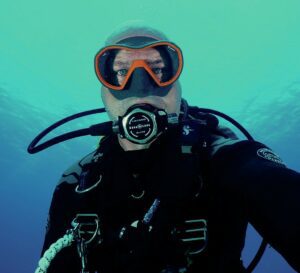Scuba Diver Editor-in-Chief Mark Evans offers a brief overview and introduction into the world of technical diving.
Scuba diving is a niche sport, we know that, but within scuba diving, technical diving is effectively a niche within a niche. We’ve all seen people venturing beneath the surface laden with stage cylinders or closed-circuit rebreathers, but what is the attraction of tech diving?
In this video, I’ll delve into the lure of technical diving, and explain why it is not all about going deep.
Technical diving. Just the name itself implies something which is complex and difficult, and perhaps out of reach of mere mortal scuba divers. It conjures up images of divers bedecked with multiple cylinders and CCRs disappearing into the depths, or venturing into some foreboding cave system. However, there is far more to technical diving than simply going deep, or performing lengthy dives inside caves.
Technical diving is usually referenced as allowing you to extend your diving beyond recreational no-decompression limits, which can mean going beyond 40m – often touted as the limit for recreational divers – but can also relate to conducting longer dives above this depth, or entering an overhead environment, where redundant air sources are essential in case of emergencies.
Technical diving can either be open circuit, using traditional scuba regulators, or closed circuit, using a rebreather. In my case, I’ll admit, I can be a bit of a depth junkie. In my early years of diving, I did some pretty deep dives on a single cylinder on air. Looking back, I can see I was lucky nothing went wrong, but I am sure we have all done things where, with the wisdom of knowledge, we can reflect and shake our heads at our youthful selves.
Technical diving was still a very fledgling sport when I first started diving, so it was never something on my radar, and now, I am so ingrained with just throwing a single tank of air or nitrox on my back, the very thought of all of the calculations and pre-dive planning that has to go into technical diving puts me off. However, these days, technical diving is much more accessible, with most of the major training agencies offering a progressive system of courses taking you from entry-level tech through to full trimix, and I reckon if tech diving was where it is now back when I was ramping up my diving, I would most certainly have gone down that route.
That said, I have dabbled in the world of technical diving. I completed the TDI Advanced Nitrox course, and qualified to use the Hollis Explorer eSCR and the Poseidon Mk6 CCR. With all of these, my aim was not to go beyond that 40m recreational limit, but to extend my time in the 30-40m realm. Often that is where all the action is, and so if I can lengthen my time at that depth, that is a good thing. When you are in the midst of a shoal of hammerhead sharks at 40m, the last thing you want to be doing is heading back to the surface after just a few minutes.
The lure of technical diving
Technical diving offers another avenue for particular divers who get to a certain level in recreational diving. Over the years, I have seen three main routes that people tend to head off in once they are a proficient recreational diver.
- One, the professional route, learning to teach people to dive and bring more people into the sport.
- Two, the photography route, where the main focus of dives becomes capturing images.
- And three, the technical diving route.
Now these are by no means absolute, and many people can combine two or even all three of these avenues into their progression through diving, but what is it about tech diving that draws people in?
Well, for one thing, all of the gear. I reckon for every proper technical diver out there, there are at least ten wannabe techies. You know the ones I am talking about – they buy the double-bladder wing, twin stages, top-of-the-line regulators, multiple torches, and so on, and then proceed to go for gentle bimbles at 20m in their local quarry. Some might occasionally go in the sea. Now I have nothing against these people – that is what they enjoy, and they are great for the industry, as they are purchasing all that top-flight gear, but they are not really using it to its full potential. They just like the kit – and all the people looking at them.
For those who go beyond the gear fetish, technical diving can be a welcome challenge. They have reached a solid level in their recreational diving, and want to go to the next level. These people relish all of the planning and preparation that goes into technical dive training and actual diving, and revel in their ability to go for deeper and longer dives than recreational divers. I know several people who went through the tech courses from various agencies to really further their knowledge and experience. For them it was the excitement and the challenge of learning new skills that drove them into technical diving. For others, technical diving is merely the method for getting to their target.
Technical diving unlocks so many more dive sites once that imaginary 40m line no longer exists. These can range from deep-water walls and reefs – I have seen some epic images of a sponge wallhundreds of metres down in the Cayman Islands – to world-class shipwrecks.
Deep-water wrecks, in particular, have a siren lure for many divers, and is often cited as the reason they got into technical diving in the first place – to be able to visit these shipwrecks. Deep wrecks are often in excellent condition, as they are not subject to surge, swell and tidal movements – not to mention storm damage – as those located in shallow depths. You only have to look at some of the incredible images of the wrecks in the Great Lakes in North America, or those in Truk Lagoon and Bikini Atoll.
Whether reef, wall or wreck, technical diving is the key to unlocking myriad dive sites that are out of reach of recreational divers. Of course, this also applies to cave diving. In an overhead environment like a cave, where you can be hundreds, if not thousands, of metres away from the exit point, you need to be self-sufficient and have redundancy in case of it all going pear-shaped.
Open circuit and closed circuit technical gear opens up so many more options when it comes to cave and cavern diving. As mentioned before, tech diving isn’t just about going deep or into cave systems, you can simply go diving for longer. And this can be a major draw in its own right. Let’s take the Thistlegorm shipwreck in Egypt. This truly world-class shipwreck sits in 30m, and with its holds full of military cargo, there is much to explore. Even with an optimum nitrox mix and excellent gas consumption, you don’t get much more than 35-40 minutes on the wreck itself.
On a daytrip to the site, your two recreational dives will barely scrape the surface of what can be seen. Now do that dive on open-circuit technical gear, or a CCR, and you are in completely different territory. I manage nearly two and a half hours on the Thistlegorm on a rebreather – my buddy and I went down with the first group of recreational divers, waved goodbye to them as they reached their no-deco limits, continued exploring the wreck with it all to ourselves, and then met up with them on their second dive and followed them back up to the boat at the end of the day. We never went deeper than 30m, but the technical equipment allowed us a vastly extended dive time.
You see so much more when the time constraints of recreational diving are removed from the equation. Many photographers are also drawn down the technical route. Using CCRs, you are completely silent, and so you can approach and interact with marine life far more than on open circuit.
The first time I went diving on a rebreather off Ras Mohammed at the tip of the Sinai Peninsula, it was mind-blowing. I was there in July, when it is breeding season, and the waters off this sheer drop-off become a veritable fish soup, with vast shoals of batfish, snapper, unicornfish and barracuda numbering into their thousands. I had done this dive many times before on open circuit, and with care, you can approach the shoals quite closely before they move away, but on a rebreather, it was totally different. Instead of moving away from me, they simply swallowed me into their ranks. It can be quite disconcerting when you have fish literally brushing against you and eye-to-eye.
Combine silent diving with extended dive time, and it is not hard to see why so many photographers have gone the rebreather route.
Is technical diving for everyone?
Let’s just say that you need a particular mindset to be a technical diver. Not everyone is cut out for it. As I eluded to before, I – and many others – just don’t have the patience or the willingness to commit to the thorough pre-dive and post-dive planning and preparation that is required, even more so when you throw closed-circuit rebreathers into the mix. I have seen too many people rush into technical diving training. You need to have all of your core skills down pat before venturing to the next stage. But if you have the necessary drive and focus, technical diving can bring so many opportunities your way. And the kit does look very cool.
- Are you a technical diver?
- Why did you get into the sport?
- If you aren’t a techie, are you tempted to go down that route?
Leave your comments below, and if you have a question, fire away – if we can’t answer, maybe someone in our community will be able to. Remember, if you enjoyed this video, be sure to subscribe to our YouTube Channel, and check out our ever-growing playlist for more educational and inspirational videos.
As always, stay safe – and if you are going diving, whether that is recreational or technical, enjoy!








